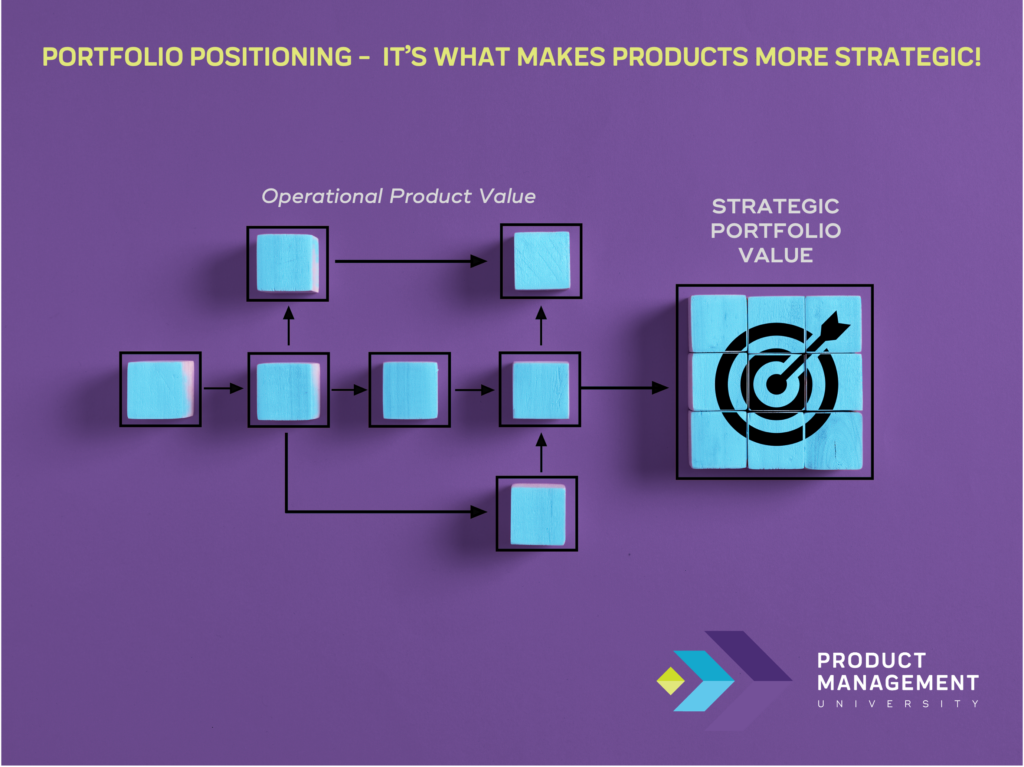Portfolio Positioning Is What Makes Your Product Positioning More Strategic

Here’s a simple example of portfolio positioning and how it makes your product positioning more strategic.
Your accounts payable product improves the customer’s cash flow. It sounds strategic. What CFO doesn’t want a stronger balance sheet?
Your accounts receivable product further enhances cash flow. Even more strategic when customers use both, right?
There’s still something missing though. What is it?
How about context? Let’s run with it and see what happens.
Beyond a healthier balance sheet, why do your target customers care about cash flow relative to their big picture strategy?
If we go back to post 3 of 10, you’ll see the ripple effect of a customer-facing portfolio vision in full swing when it’s time to craft your portfolio (and product) positioning!
Remember, your portfolio vision is the ultimate business outcome customers get from your portfolio, and that’s the key to creating a strategic value message for your portfolio. In fact, they’re one and the same with some minor wordsmithing if done right.
Let’s give it the acid test.
If your portfolio vision (and your portfolio value message) are about “giving customers greater financial flexibility to execute their strategic priorities,” does a healthier balance sheet contribute to that goal by eliminating cash flow problems?
You bet it does! So even when buyers are only looking to buy one of your financial solutions, the lead message is always “greater financial flexibility to…strategic priorities.”
Each additional product in your portfolio of financial solutions contributes to and strengthens your portfolio message by eliminating further obstacles to the ultimate customer goal, greater financial flexibility.
Since this series is all about ripple effect, let’s look at the strategic ripple effect of strong portfolio positioning.
- It gives sales and marketing a powerful story and most importantly one that’s simple to internalize and repeat because it’s customer centric, not product centric. This is what differentiates you more than anything.
- Depending on the purpose or campaign, you can lead with the ultimate outcome (usually not recommended) or the more emotional obstacles/pain points your portfolio eliminates (highly recommended). Either way, both components give your story complete context.
- 80% of your value story is built around things customers do and why they do it, not your products. Remember, products are the proof points in a strong value story.
I’ve probably said this a million times (OK, maybe a few thousand), buyers don’t engage and buy because they understand you. They’ll engage and buy from you versus your competitors because you understand them far better.
Build your portfolio and product positioning with that goal in mind and you’ll nail it every time.
Click here if you want to experience the easiest way to learn product management, product marketing, portfolio marketing, pre-sales demos and customer success with our unique hands-on learning format. Be sure to check out our Product Management Framework that simplifies everything by making customer outcomes the starting point for building, marketing, selling and delivering strategic value.
Becoming More Strategic
- Portfolio Management 6 of 10 – A Product Roadmap Isn’t Just a Product Thing
- Portfolio Management 5 of 10 – Integrating Business Processes vs. Products
- Portfolio Management 4 of 10 – Market Strategy vs. Product Strategies
- Portfolio Management 3 of 10 – Portfolio Vision
- Portfolio Management 2 of 10 – Bridging the Gap on Customer Discovery
- Portfolio Management 1 of 10 – Forecasting Revenue
Subscribe to The Product Vibe or follow Product Management University on LinkedIn to make sure you get the 10-part post.
by John Mansour on October 16, 2023.